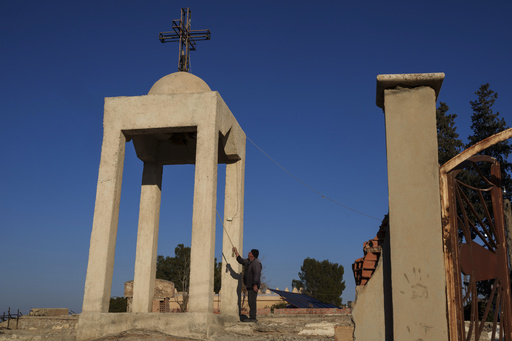
TEL TAL, Syria — A somber moment unfolded for the Christian community in Syria as the sound of a church bell echoed in an empty space where the Saint Odisho church used to welcome worshippers. This church was destroyed a decade ago by the Islamic State group, leaving the village of Tel Tal nearly deserted.
Ishaq Nissan, a local Christian who escaped the violence, walked through the deserted streets and pointed to abandoned homes, recounting the fates of families who had relocated to various countries, such as the United States, Australia, Canada, and nations in Europe.
This month marks a significant anniversary, as the Christians in northeast Syria observe the tenth year since IS attacked over thirty villages along the Khabur River. On February 23, 2015, the assault resulted in numerous casualties and over 200 individuals being taken captive. Many churches were demolished, forcing thousands to flee their homes.
As this milestone approaches, the Christian community expresses concerns about Syria’s future following the December ousting of President Bashar Assad, driven by insurgents from the Islamist group Hayat Tahrir al-Sham (HTS). Ahmad al-Sharaa, the HTS leader, has since assumed the role of interim president, with government roles predominantly filled by members from Islamic factions.
Al-Sharaa has assured that the rights of all religions will be upheld in Syria’s post-Assad era. Despite being affiliated with al-Qaida in the past, HTS has opposed IS and has fought against it in various intense battles. Although IS was defeated in 2019, sleeper cells remain active and continue to conduct attacks.
Since Assad’s departure, there have been incidents targeting Christians. For instance, a Christmas tree was set ablaze last December in Suqailabiyah village, which authorities described as an isolated event.
Syriac Orthodox Archbishop Maurice Amsih, leader of the church in the northeast, expressed his hopes for collaboration among all factions to secure rights for everyone in Syria. He emphasized that Christians desire to be treated civilly, distancing themselves from Islamic governance.
Meanwhile, Western nations have urged the new ruling powers in Syria to ensure the protection of rights for religious and ethnic minorities, alongside women’s rights. The dominant faith in Syria is Sunni Islam, constituting the majority of the populace, while Christians, Druze, and Alawites account for approximately one-quarter of the population.
Prior to the war, Christians represented about 10% of Syria’s 23 million inhabitants, existing alongside a Muslim majority and enjoying freedom of worship under Assad’s regime, where the last parliamentary speaker was Christian. However, the outbreak of the civil war in 2011, initiated by an uprising against Assad’s rule, led to the exodus of hundreds of thousands of Christians, with the rise of IS significantly contributing to their flight.
“We were living in peace and never imagined this dark day would occur in our modern history,” stated Elias Antar Elias, a Tel Tal resident who serves as a representative for the Khabur River region in the Kurdish-led administration of northeast Syria.
At the age of 78, he recounted fleeing with his family in the dead of night as extremists attacked one Christian village after another, instilling terror in a community that had known relative tranquility for many years. He eventually relocated to Hassakeh until Kurdish and Christian forces managed to regain control of his hometown.
The imagery of horror remains vivid for Elias, who described witnessing the bodies of Christians mutilated by animals on the roadside, a sight that continues to haunt him. Before the IS onslaught, Tel Tal was home to roughly 400 residents, whereas now only about 30 remain.
Reflecting on the past, Elias highlighted the significance of the Saint Odisho church, recalling moments such as baptisms and his wedding that took place there. When asked why his family remained while others departed, he answered, “I love this place. Our graves and our martyrs are here. This is our land.”
The archbishop noted that prior to the 2015 attack, 34 Christian villages along the Khabur River housed around 45,000 Assyrians. He also estimated that before the civil war, approximately 2.2 million Christians lived in Syria, with roughly two-thirds likely having fled the country.
In the nearby village of Tel Nasri, the Christian population has dwindled, replaced by displaced individuals from other regions, although the Church of Virgin Mary still stands, albeit in a damaged state following the 2015 bombing.
Despite the violent past, some Christians intend to stay in Syria, facing an unpredictable future under new leadership. Janet Chamoun, who was praying in Qamishli in 2015 during a bomb explosion, vividly remembers the chaos and destruction. Despite the fear, she and her daughter chose to remain.
“Our home and roots are here,” Chamoun stated outside the restored Virgin Mary Syriac church, where she continues her daily prayers.

